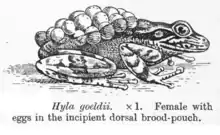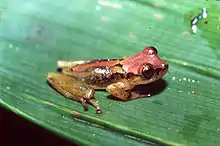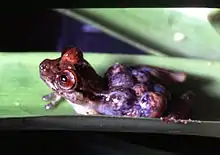Fritziana
Fritziana is a genus of frogs in the family Hemiphractidae.[1][2] They are endemic to southeastern Brazil and found on the mountains and adjacent coastal lowlands from Espírito Santo to São Paulo state.[1][3]
| Fritziana | |
|---|---|
 | |
| Fritziana goeldii, the type species | |
| Scientific classification | |
| Kingdom: | Animalia |
| Phylum: | Chordata |
| Class: | Amphibia |
| Order: | Anura |
| Family: | Hemiphractidae |
| Subfamily: | Hemiphractinae |
| Genus: | Fritziana Mello-Leitão, 1937 |
| Type species | |
| Hyla goeldii Boulenger, 1895 | |
| Species | |
|
See text | |
| Synonyms | |
|
Fritzia Miranda-Ribeiro, 1920 — junior homonym of Fritzia | |
Taxonomy
The genus has been considered synonym of Flectonotus, but was recognized again in 2011.[1][3] The former Flectonotus consisted of two geographically disjunctive components, one from northern South America (Flectonotus as understood today) and the other from southeastern Brazil (Fritziana).[3] The distinctiveness of these taxa is now well established and based on both molecular, behavioural, and morphological characters.[1][3]
Species
The following species are recognised in the genus Fritziana:[1][2]
- Fritziana fissilis (Miranda-Ribeiro, 1920)
- Fritziana goeldii (Boulenger, 1895)
- Fritziana izecksohni Folly, Hepp, and Carvalho-e-Silva, 2018
- Fritziana mitus Walker, Wachlevski, Nogueira da Costa, Nogueira-Costa, Garcia, and Haddad, 2018
- Fritziana ohausi (Wandolleck, 1907)
- Fritziana tonimi Walker, Gasparini, and Haddad, 2016
- Fritziana ulei (Miranda-Ribeiro, 1926)
References
- Frost, Darrel R. (2018). "Fritziana Mello-Leitão, 1937". Amphibian Species of the World: an Online Reference. Version 6.0. American Museum of Natural History. Retrieved 11 March 2018.
- "Hemiphractidae". AmphibiaWeb: Information on amphibian biology and conservation. [web application]. Berkeley, California: AmphibiaWeb. 2018. Retrieved 11 March 2018.
- Duellman, William E.; Jungfer, Karl-Heinz; Blackburn, David C. (2011). "The phylogenetic relationship of geographically separated "Flectonotus" (Anura: Hemiphractidae), as revealed by molecular, behavioral, and morphological data". Phyllomedusa. 10 (1): 15–29. doi:10.11606/issn.2316-9079.v10i1p15-29.

